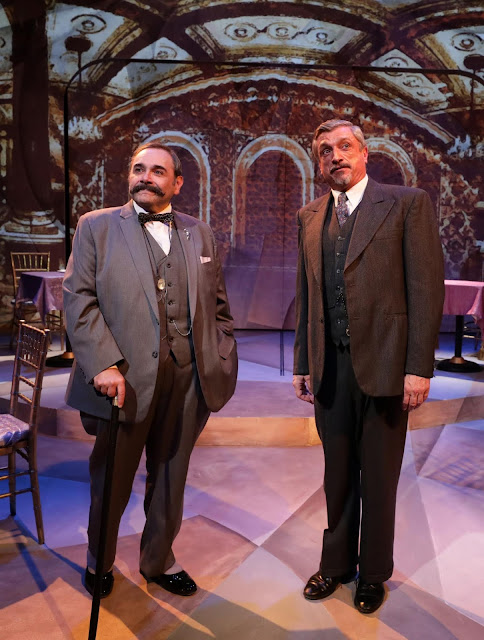 |
| Remo Airaldi & Will McGarrahan in "Murder on the Orient Express" (photo: Mark S. Howard) |
Well,
make that eight suspects walk into a pullman car. The self-appointed
jury of twelve first seen in the iconic novel by Agatha Christie and
seen subsequently on several movie and TV screens over the years has
been reduced to eight (thus canceling out Christie's clever allusion
to a jury of one's peers); hence the current stage adaptation by Ken
Ludwig (“at the request of the Christie estate”) of Murder on
the Orient Express , now being produced by Lyric Stage Company,
has already lowered expectations somewhat. This is not necessarily a
bad thing, since anyone who has seen any of the more successful
iterations of this concept might not want to revisit an exact
reenactment of the popular story with a full dozen backstories. Yet
it's actually hard to envision a potential audience member out there
who hasn't already experienced the absurdly coincidental tales of the
interrelated passengers who all happen to find themselves on the same
track at the same time, or the clever twist at the end, which was,
and continues to be, literally unforgettable . That said, this
offering, Directed by Spiro Veloudos, makes up for its possible
element of real mystery with a chance to see some local actors
theatrically strut their shtick.  |
| The Cast of "Murder on the Orient Express" (photo: Mark S. Howard) |
And
strut they do, as the famed Orient Express train is trapped by an
avalanche in a snowstorm shortly after midnight. As the script puts
it, “And so it begins”. In no time at all, an American tycoon is
suddenly found murdered in a compartment which is locked from inside.
Among the other passengers and crew are eight potential suspects, all
of whom have ironclad alibis (and motives). By chance or by choice
(Agatha Christie's, that is), it just so happens that one of the
passengers aboard the train is none other than the justly famed
Belgian private detective Hercule Poirot (Remo Airaldi). It is his
role to interrogate and investigate the Conductor Michel (Scot
Colford, who also plays the Head Waiter), Princess Dragomiroff (Sarah
deLima), Helen Hubbard (Kerry A. Dowling), Greta Ohlsson (Marge
Dunn), Monsieur Bouc (Will McGarrahan), Colonel Arbuthnot (Davron S.
Monroe, who also plays Rachett), Hector MacQueen (Michael John
Ciszewski), Countess Andrenyi (Celeste Oliva), and Mary Debenham
(Rosa Procaccino). One semi-spoiler: the Butler didn't do it (seeing
as there isn't one). But the heavily expository nature of most of the
entire first act doesn't help; it was disorienting. Some jokes fit,
some do not, and some arrive overdone (three times we're told Poirot
is Belgian, not French). Fortunately, the overly familiar plot
becomes less involving than the appreciation of the acting chops on
display as well as the creative contributions.
 |
| The Cast of "Murder on the Orient Express" (photo: Mark S. Howard) |
On that creative side, the Scenic Design is by Brynna Bloomfield (serviceable and clever but not nearly as posh as the real Orient Express, which the script extols as a “legend”), with Costume Design by Gail Astrid Buckley (becoming threads from the period, which is 1934), effective film noir-ish Lighting Design by Scott Clyve, Sound Design and Original Music by Dewey Dellay (with some snippets from Anything Goes, and Flight of the Bumblebee as well as Chattanooga Choo-Choo) and fluid (in fact, constant) Projection Design by Seaghan McKay. They're the true suspects in this melding of art deco and film noir. The Direction by Veloudos is solid, especially in the second act, and the acting turns are universally tantalizing, with standouts from Airaldi, Dowling and McGarrahan in the meatier roles. It's also the screen debut (no, that's not a typo) in a brief role by young actress Josie Chapuran as Daisy Armstrong.
 |
| The Cast of "Murder on the Orient Express" (photo: Mark S. Howard) |
Whodunnit?
Or who didn't? Did he/she deserve it, and does it really matter?
Find out who, what, where and most of all why. In the beginning, the
script proclaims that “If you break the rules, you pay the price”;
in the end, it was “all about justice”, and “doing the right
thing”.
It's
now deducible at Lyric Stage Company through December 22nd.
And oh, what a cast of characters to suspect!

















